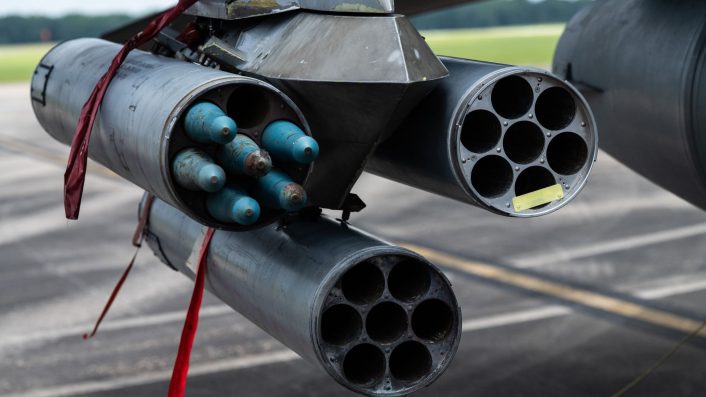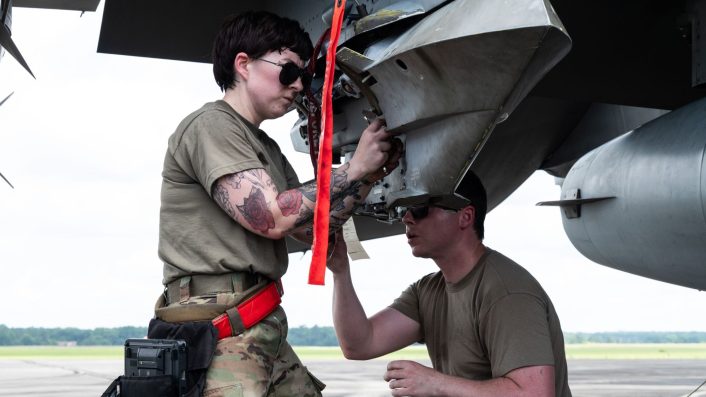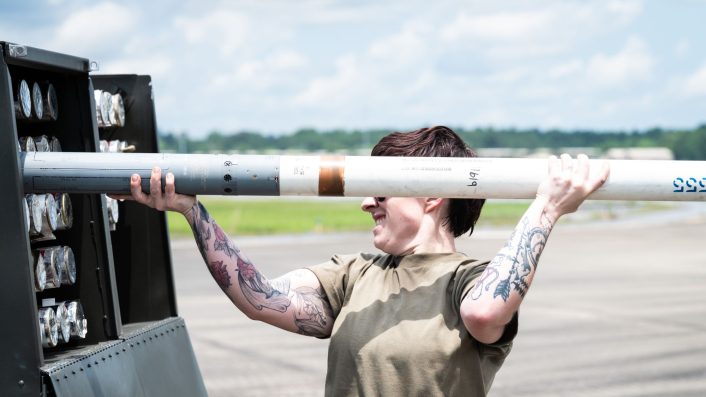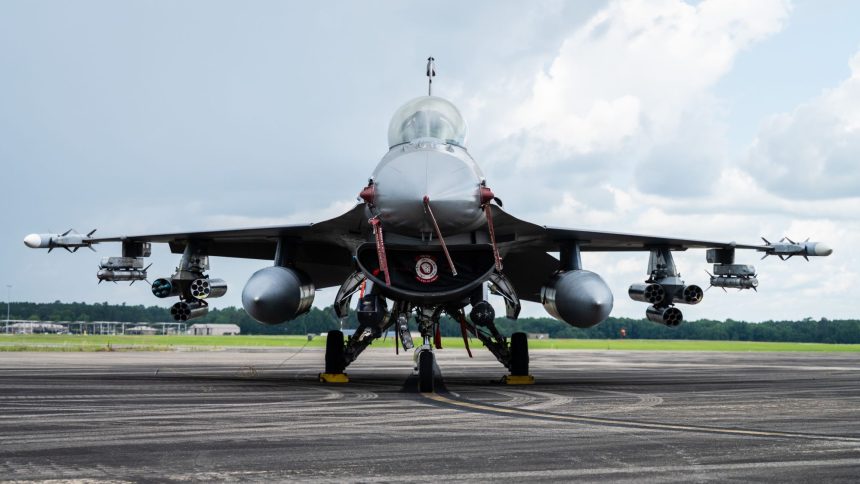By carrying six LAU-131 A/A rocket pods, the F-16 will be able to carry up to 42 AGR-20 Falco rockets, matching the F-15E’s payload for Counter-UAS missions.
The U.S. Air Force’s 20th Fighter Wing (FW) at Shaw AFB, South Carolina, has released images of one of its F-16C/D Fighting Falcons loaded with six seven-round LAU-131 A/A rocket pods on Triple Ejector Racks (TER), carrying APKWS II (Advanced Precision Kill Weapon System). While in the image not all pods are loaded with rockets, the images show that the F-16 can now carry up to 42 rockets.
Both the weapon and the carrier aircraft, the F-16, were already used in counter-drone air-to-air roles against Houthi projectiles, although so far they used smaller magazine capacity compared to these photos. In fact, F-16s in the CENTCOM (Central Command) Area of Responsibility (AOR) have been seen carrying only up to two such pods on the TER.
As reported by The Aviationist in May, an F-15E Strike Eagle from the 96th Test Wing’s 40th Flight Test Squadron at Eglin AFB was seen carrying three LAU-131A/As on the left wing mounted on a TER. Then, by the end of the month, F-15Es were shown in the CENTCOM AOR equipped with six pods, for a total of 42 rockets, in addition to eight air-to-air missiles.
The F-16’s images were taken on Jun. 10, 2025, based on the VIRIN details, and later released on the DVIDS network on Jul. 15. They show personnel of the 20th Equipment Maintenance Squadron Weapons Standardization Sections installing the TERs on the middle wing pylons, stations 3 and 7, as well as extracting the rockets from the transport cases and loading them into the pods.

What the images show
The images released show only one pod on the right wing’s TER loaded with the APKWS II rockets, while the others are empty. That pod too is carrying only six rockets, instead of its capacity of seven rounds.
It is not clear if all the pods were eventually loaded with the weapons during the test, and if the aircraft later flew. On the contrary, the 96th TW’s F-15E seen in May had all its six pods loaded, delivering the full intended 42-round capacity.
Just came across this picture of a Shaw Viper carrying 6x rocket pods. Only one of those is visibly loaded with inert AGR-20s here, but the loadout should confirm the long theorized and likely planned 42x APKWS configuration which matches the F-15E’s magazine depth. pic.twitter.com/zhapMLCucu
— Abd (@blocksixtynine) July 14, 2025
The rockets in the images are not the standard APKWS II variant. In fact, one of the captions identify them as the AGR-20F Fixed Wing, Air Launched, Counter-Unmanned Aircraft Systems Ordnance (FALCO), a variant with upgraded software to improve the counter-UAS capabilities.
The new photos suggest the effort to have greater airborne counter-drone capability in the Middle East and the USAF perceiving those threats to persist, at least in the near future. Both the F-16s and the F-15E Strike Eagles will now be able to employ a deeper magazine during operations in the CENTCOM AOR.
A caption described the AGR-20 as a “highly accurate, low-cost option to counter small aerial threats like one-way attack drones,” referring to its role against the Houthis.

AGR-20 APKWS II
The AGR-20 APKWS II is a conversion of the Hydra 70 unguided rockets, with a laser guidance kit added to the baseline weapon. The system sits between the 10-pound high-explosive warhead at the front of the rocket and the Mk66 Mod 4 rocket motor at the rear, turning it into a precision-guided munition (PGM).
Specifically, the guidance section includes wing-mounted laser seeker collection optics on the four foldable wings, offering a wide field of view, and enabling it to engage both moving and stationary targets. The U.S. DoD (Department of Defense) designated the standard APKWS II the AGR-20, and the FALCO variant the AGR-20F.
The low-cost smart munition is a cheaper and effective alternative to engage asymmetric one-way attack drones, which cost between $15,000-$20,000, instead of using the larger and more expensive AIM-9 Sidewinder and AIM-120 AMRAAM (Advanced Medium-Range Air-to-Air Missile). In fact, an AIM-9X costs about $450,000 and an AIM-120 more than $1 million, while a single APKWS II rocket is estimated to have a price point of around $30,000.
APKWS’s developer BAE Systems unveiled at the Sea Air Space 2025 conference in Apr. 2025 a new Advanced Precision Kit (APK), consisting of an IR (InfraRed) seeker in addition to the existing laser guidance, making the APKWS a dual-mode weapon. The addition of an IR seeker spares pilots the need for continuous lasing of aerial targets like the Houthis’ cheap kamikaze drones, allowing swiftly moving on to other threats.
The APK upgrade by BAE Systems served as the “next stage” in the rocket system’s evolution. It is unclear if the service has already awarded a contract for the new APK and if testing is in progress.

F-16s and AGR-20
The Aviationist reported in Feb. 2025 that U.S. Air Force F-16s deployed to the CENTCOM (Central Command) AOR (Area of Responsibility) have been employing the APKWS II in the air-to-air role against Houthi projectiles over the Red Sea since 2024. The service previously announced in 2019 that the APKWS II was tested in the air-to-air role, and the weapon is now in operational use against the Houthis.
While BAE Systems previously said no modifications are required to the rocket, firing platform or fire control system, the only known different requirement is for the rocket to be carried by the F-15 or F-16 in a longer variant of the LAU-131/A 7-round rocket launcher normally employed by the U.S. Air Force, called the LAU-131 A/A (the Navy uses the AGR-20 with the similar LAU-68 F/A).
“The F-16’s ability to carry six AGR-20 pods in a single loadout makes it one of the most cost-effective multirole platforms in the U.S. Air Force inventory,” said one caption. Another caption said the F-16 offers “exceptional reach and responsiveness, making it a critical asset for both U.S. and allied air forces especially when utilizing the AGR-20F platform.”
Ukrainian Navy’s VAMPIRE anti-drone system using low-cost laser-guided APKWS rockets against Russian Shahed-136 kamikaze UAVs in Odesa region.
The U.S. Air Force already employs APKWS on F-16s to cheaply counter Houthi drones and plans to add a passive IR seeker to create a… pic.twitter.com/iDx01Yy2z0
— Clash Report (@clashreport) February 16, 2025
The lightweight single-engine aircraft is the backbone of the service’s air-to-air and air-to-surface missions. Their criticality is also reflected in the 51st FW at Osan Air Base, South Korea, receiving F-16s Block 50 airframes with the PoBIT (Post-Block Integration Team) upgrades, featuring new radar, computers and electronic warfare systems, to complement its Block 40 airframes.










